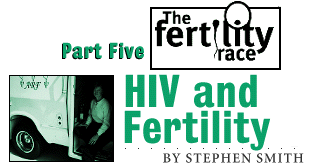





Experimental HIV Program
MPR News Feature
Text,
Audio
Supreme Court Ruling
A report on the June 25, 1998 decision that people with HIV qualify for legal protection under the Americans with Disabilities Act.
Text, Audio
The Supreme Court text of Abbott v. Bragdon
Diagnosis and Reporting HIV
This in-depth CDC report requires Adobe Reader to view. Select Issue No.15 at the top of the page to download the PDF file, or select "Diagnosis and Reporting..." for an overview.
Fertility Race Home
Access to other installments in the series.
| 

 |
NOT SO LONG AGO, a positive HIV test seemed like a death sentence. HIV almost invariably led to AIDS, and AIDS was almost always fatal. Now, some people infected with HIV are living longer, healthier lives than once expected thanks to new drug therapies that keep the virus at bay. This means that some HIV-infected Americans are pursuing a dream they once thought off-limits: having children. The new drugs extend life but do not eliminate the risk of getting HIV from unprotected sex. An unusual new
program in Boston aims to help HIV-positive men and their uninfected female
partners have a baby without passing along the virus.
New Options
Charley and Barbara consider having a baby for the first time.
Infertile Because of HIV
The Assisted Reproduction Foundation seeks to help serodiscordant couples.
Washing Away the Virus
A new procedure may reduce the risks of HIV transmission to mothers.
High-Tech May Lower Odds
Ann Kiessling's mobile clinic has created new options for patients.
Difficult Decisions
Harrison and Lilly are realistic about the possibilities.
May 4, 1998
|


![[NPR] height=](/features/199711/20_smiths_fertility/images/npr.gif)
![[MSNBC]](/features/199711/20_smiths_fertility/images/msnbc.gif)
![[CPB]](/features/199711/20_smiths_fertility/images/cpb.gif)
![[Kaiser Family Foundation]](/features/199711/20_smiths_fertility/images/kaiser_logo.gif)